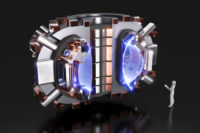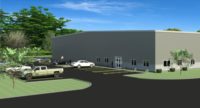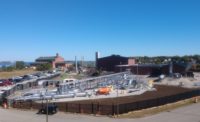A nuclear fusion startup led by scientists at MIT on Sept. 8 announced a major advance that the team says could pave the way for the world’s first commercial fusion power reactor by the end of the decade.
Researchers at Commonwealth Fusion Systems (CFS) and MIT’s Plasma Science and Fusion Center (PSFC) conducted a successful test of key magnet technology that generated a sustained field of more than 20 teslas, a unit of intensity for magnetic fields (one newton force per ampere of current per meter of conductor). Findings were announced in a Zoom press conference.
The test, conducted Sept. 5 at MIT, achieved a major milestone in fusion research: It produced a sustained magnetic field strong enough to produce more power than it took in, the Commonwealth/MIT research team said.
The power production will be enough to operate the firm’s planned, compact fusion test reactor, called SPARC, and scheduled for a test in 2025, researchers announced.
Never Done Before
The “record breaking” magnet test results will provide “a clear path to fusion power for the first time,” said Bob Mumgaard, Commonwealth Fusion CEO. “That has never been done before—more energy out than in.”
Researchers at the firm and MIT have focused their efforts on building more powerful magnets that will create stronger magnetic fields to achieve fusion in a relatively smaller-scale Tokamak-style magnetic confinement device.
That, in turn, significantly reduces the scale of the facilities needed to generate a fusion reaction. The planned SPARC test reactor is set to be the size of a high-school gym, compared to the massive $22-billion ITER project in southern France, which is the size of a hockey stadium.
The ability to produce a fusion reaction in a manageably sized reactor is a key part of Commonwealth’s plans, which are focused on developing fusion into a commercially available power source.
Manageable Size, Manageable Price
The project’s price, at $500 million, is also much smaller than that for ITER, which has cost tens of billions to build. The test plant and the later commercial pilot are designed “to be modular,” with the ability “to pull parts in and out … instead of months to take down,” said Maria Zuber, MIT’s vice president for research.
While the scientific community has known of the energy producing potential of fusion for decades, working out the science and engineering behind it has been a long process.
Commonwealth and MIT researchers last year published a number of peer-reviewed papers in scientific journals laying out the science behind the current research that is now being conducted.
“This was not designed to be a scientific experiment,” Zuber said. “It uses decades of fundamental research. The physics is well-known.”
The next step will be building SPARC, the mini-reactor that will allow researchers to study the physics of fusion reactions, also referred to as burning plasma, which has been likened to bringing a mini-sun or star to Earth.
If that proves successful, Commonwealth and MIT will begin work on the world’s first commercial fusion reactor, with a pilot plant potentially ready by the early 2030s or possibly by the end of this decade.
As it ramps up its research, Commonwealth, which is financed by private investors, has begun work on a 47-acre headquarters complex in Devens, Mass., a former U.S. Army base that has been turned into a manufacturing, industrial and life sciences park.
That project is expected to cost hundreds of millions to build, with hopes of having the test reactor and a manufacturing facility built by next year.
A big plus of fusion energy is the combination of a potentially limitless source of energy using readily available fuel—hydrogen—with fairly manageable waste, researchers say.
That limitless supply could give fusion a major edge not just over fossil fuels, but also renewable sources of energy that are weather dependent, said Ranganathan Gopalakrishnan, a mechanical engineering professor at the University of Memphis who is involved in his own research project around the use of nuclear fusion to generate power.
Fusion plants could also be plugged into the current grid without a lot of restructuring as well, Gopalakrishnan said.
He sees the potential for a pilot commercial fusion plant operating in the mid-2030s, followed by a wider rollout in the 2040s.
“There is still a long way to go,” Gopalakrishnan said. “This is the first time where they have gotten so much energy out compared to what they put in. “That is definitely a breakthrough.”





